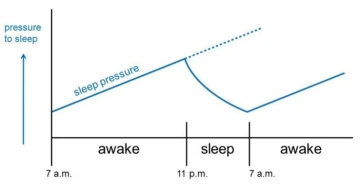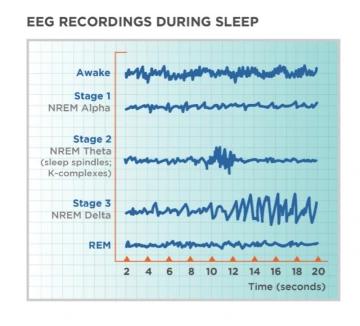Sleep 101
Sleep is one of our basic daily needs and we need consistent, good quality sleep to function our best. Most adults need 7 to 9 hours of sleep, but this can vary depending upon life circumstances. However, 75% of firefighters experience clinically significant sleep disturbances on and off shift.
(Dal Lae et al., 2023)
These disturbances are highly related to:
- Hypertension, cardiovascular disease, and cardiovascular events - the leading cause of on-duty firefighter death
- Increased risk for infectious disease
- Depression and other mood disorders
- Increased stress
- Cancer
- Weight issues and metabolic syndrome
- Fertility issues
- Type 2 diabetes
- Decreased attention/alertness, decision making, and memory
- Poorer performance
Optimizing firefighter sleep is essential for sustaining long-term health, wellbeing, and peak performance.
How Does Sleep Work?

Firefighters often face unpredictable schedules, and that unpredictability can make it hard to achieve quality sleep. Understanding how the body regulates sleep can help improve rest and recovery, even in the face of a demanding shift.
One of the key systems controlling your sleep is called the sleep drive, or Process S. This biological process builds steadily the longer a person remains awake, creating increasing pressure to sleep. After a full night of rest, the sleep drive is at its lowest.
As wakefulness extends through a long shift, the sleep drive intensifies, making it easier to fall asleep and stay asleep once the opportunity for rest finally comes.
Why timing matters – especially for firefighters
Falling asleep on the couch too close to bedtime can reduce your sleep drive at the worst possible time. That can make it harder to fall asleep or get the restorative rest you need between shifts. On the other hand, staying awake longer increases your sleep drive. This can actually help you fall asleep faster better sleep when the timing is right. For example, if you’ve been awake for 16 hours straight, you’re more likely to fall into a deep, uninterrupted sleep than if you’d only been up for a couple of hours.
The problem, of course, is what happens before you get that sleep.
The longer you're awake, the more your performance suffers—especially when it comes to reaction time, decision-making, and situational awareness. After 18-19 hours without sleep, your cognitive function can dip to levels similar to being legally intoxicated. In high-stakes environments like emergency response, even a small lapse can have serious consequences.
Your body also runs on a second system: your internal clock, or circadian rhythm. This system follows a roughly 24-hour cycle and helps regulate when you feel alert versus when you feel sleepy. Disruptions like night shifts or back-to-back calls can change the timing or expression of your circadian rhythms, making it even harder to get quality sleep and especially at certain times of the day.
What Is The Brain Doing When We Sleep?

Although it may seem that sleep is a quiet time with not little activity, many processes are happening in our brain during sleep.
When healthy sleepers begin to fall asleep, they enter Stage N1. This stage serves as a bridge between wakefulness and sleep and is considered a very light stage of sleep. If someone were awakened from Stage N1, they would likely report that they had not been sleeping.
From Stage N1, the sleeper transitions into Stage N2, where approximately 40% to 55% of the night is spent. Stage N2 is still a light stage of sleep, though deeper than N1. During this stage, the brain produces bursts of activity known as sleep spindles. Experts believe these spindles help protect sleep by suppressing responses to external stimuli, such as sounds or smells.
Stage N3 follows stage N2 sleep. Stage N3 is often called slow wave sleep, delta sleep, or deep sleep. It is the deepest sleep stage. This stage is thought to be essential for brain repair and physical restoration. Awakening someone from Stage N3 requires more effort than from the lighter stages of sleep. If a firefighter has difficulty waking up in response to the tones, it may be because the alert occurred during Stage N3.
The final stage of sleep is Rapid Eye Movement sleep or REM sleep. This is the stage of sleep where we do most of our dreaming. Heart rate and breathing rate change a lot in this stage, and more blood flows to the brain. Even though there is a lot of activity within the body systems during REM sleep, the body’s muscles are very relaxed. This is a good thing because it keeps people from physically acting out their dreams. REM sleep closely resembles Stage N1 or even wakefulness on a brain activity monitor. REM is thought to play a vital role in emotional processing and memory consolidation.
Key Points:
- Sleep is an active time for our brain even though our body is very still
- Slow wave sleep is important for rest and recovery
- REM is important for emotional processing
Lifestyle Factors Affect Sleep
Firefighters often face long shifts and interrupted sleep, which can lead to reliance on substances like caffeine, nicotine, alcohol, and cannabis to either stay awake or wind down. While these substances may seem helpful in the short term—providing a quick boost of alertness or a way to relax before bed—they can actually interfere with the quality and structure of sleep. This section explores how each of these commonly used substances affects the sleep-wake cycle, and why their use as sleep or wake aids may do more harm than good.
Key Points:
- Caffeine, nicotine, alcohol, and cannabis negatively impact sleep and sleep architecture
- Slow wave sleep is important for rest and recovery
- REM is important for emotional processing
Need Support with Sleep or Changing Lifestyle Behaviors?
Every agency participating in this study will receive a Sleep Fitness Program designed to help manage the challenges of shift work and improve recovery sleep. While these programs are being rolled out, support is already available.
Immediate Resources Available to You:
Your agency may offer an Employee Assistance Program (EAP) that provides practical tools and referrals for sleep, stress, and overall well-being.
Check below for you EAP provider or contact your agency.
- Alliance Work Partners (AWP) Users: Find resources at the AWP Now website.
- CIGNA Users: Log in through MyCigna or use the myCigna app.
- ComPsych Users: Log in via the Guidance Resources website.
- Global Medical Response (GMR): Learn more on their Employee Wellness Resources webpage.
- Optum Users: Visit Live and Work Well.
- Public Safety Crisis Solutions Users: Access support through the Public Safety Crisis Solutions website.
- Jorgensen Brooks Users: Access support via the Jorgensen Brooks website.
- SuppottLinc.com Users: Log in via the SupportLinc website.
Additional resources
- Interested in quitting tobacco? Free coaching is available through the ASHLine.
- Want to learn more about healthy sleep? Visit the National Sleep Foundation for trusted information.





